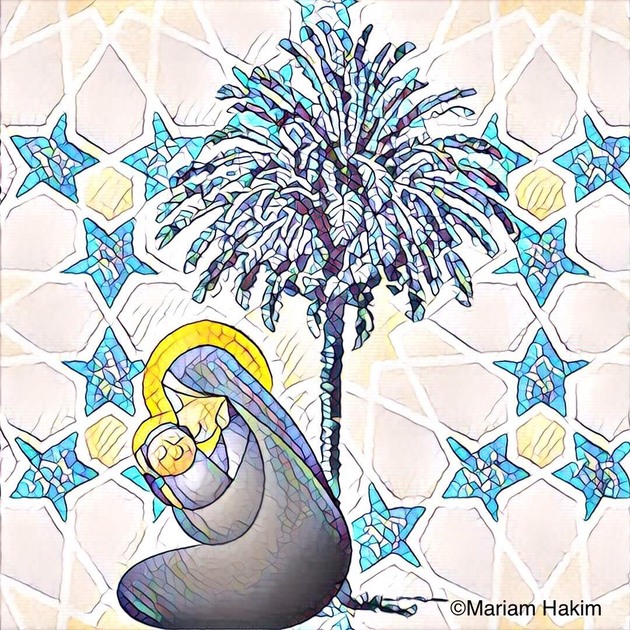Because so many of us are unfamiliar with both Islam and the Quran, we perhaps don’t know about the Quranic nativity story found in Maryam. It is a story of the birth of Jesus unfamiliar in many ways. Maryam (Surah) 19:16 – 30
And mention Maryam in the Book when she drew aside from her family to an eastern place;
So she took a veil (to screen herself) from them; then We sent to her Our spirit, and there appeared to her a well-made man.
She said: Surely I fly for refuge from you to the Beneficent God, if you are one guarding (against evil).
He said: I am only a messenger of your Lord: That I will give you a pure boy.
She said: When shall I have a boy and no mortal has yet touched me, nor have I been unchaste?
He said: Even so; your Lord says: It is easy to Me: and that We may make him a sign to men and a mercy from Us, and it is a matter which has been decreed.
So she conceived him; then withdrew herself with him to a remote place.
And the throes (of childbirth) compelled her to betake herself to the trunk of a palm tree. She said: Oh, would that I had died before this, and had been a thing quite forgotten!
Then (the child) called out to her from beneath her: Grieve not, surely your Lord has made a stream to flow beneath you;
And shake towards you the trunk of the palmtree, it will drop on you fresh ripe dates:
So eat and drink and refresh the eye. Then if you see any mortal, say: Surely I have vowed a fast to the Beneficent God, so I shall not speak to any man today.
And she came to her people with him, carrying him (with her). They said: O Maryam! surely you have done a strange thing.
O sister of Haroun! your father was not a bad man, nor, was your mother an unchaste woman.
But she pointed to him. They said: How should we speak to one who was a child in the cradle?
He said: Surely I am a servant of Allah; He has given me the Book and made me a prophet;
This story is the basis of a recent article in the Huffington Post by Muslim author Mariam Sheikh Hakim. She relates the story of her childhood in the US and parents who were recent immigrants. As a child, she often asked her parents for a Christmas tree. And they always felt that it wasn’t proper for a Muslim family to have a Christmas tree. However, as a family they were observant and not strict Muslims, so decades later her parents are grandparents who enjoy giving Christmas gifts to their grandchildren. However, having a Christmas tree is a step too far.
Mariam thinks that many Muslims who participate in the cultural aspects of Christmas in western nations still avoid the Christmas tree because of the tree’s, as well as many other of the adornments of Christmas, connection to Northern European pagan faiths. She points to the late adoption of the tree in the Christmas traditions of many Christian nations for the same reason. She also attributes the adoption of Northern European customs and swaddling Christmas in them, as having robbed us or blinded us to Christmas’ Middle Eastern connection. And having lost that connection, western nations bomb the Middle East with impunity and send its nation’s populations scurrying for shelter to nations where they are met with disdain, indifference and xenophobia.
She boldly suggests two things about the Quranic nativity story; the first is that Christians might view it as a road back to the Middle Eastern setting as the actual birthplace of Jesus and then start surrounding the celebrations of the nativity with images and symbols that represent its true locale. This might make the Middle East less foreign to the Christian psyche and offer a greater relationship to that part of our world. The second is that remembering the Quranic story of the Nativity might offer Muslims a reminder of their shared connection with the Christians of the world.
Read Mariam’s full take on these ideas in her post. She also is the artist who created the main image used for this story.

